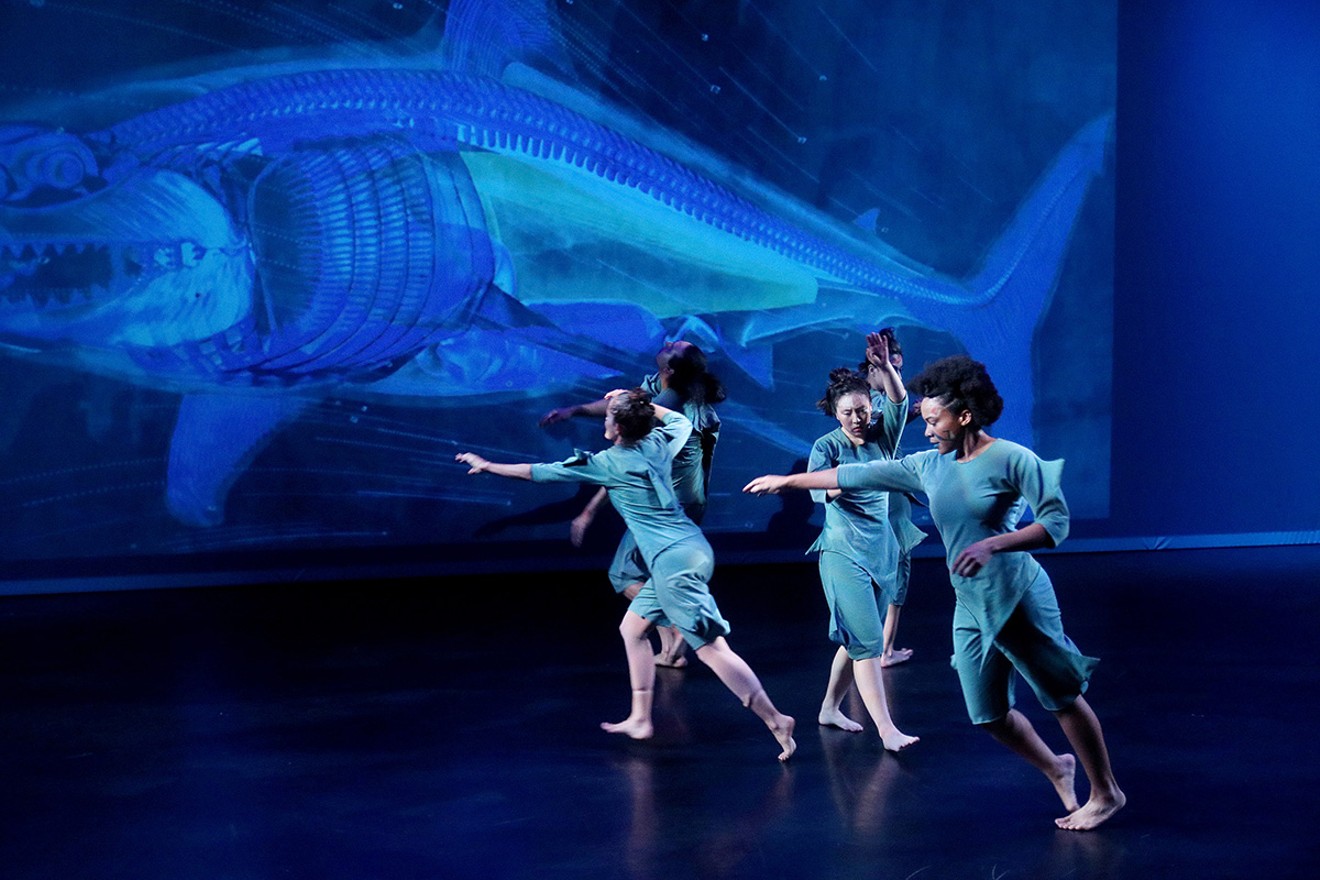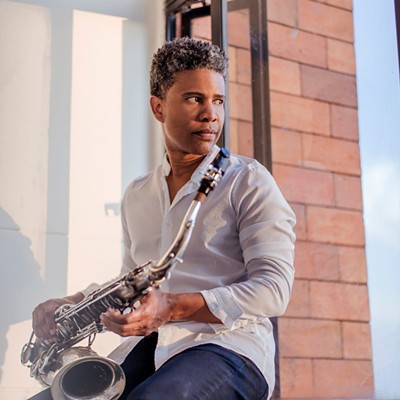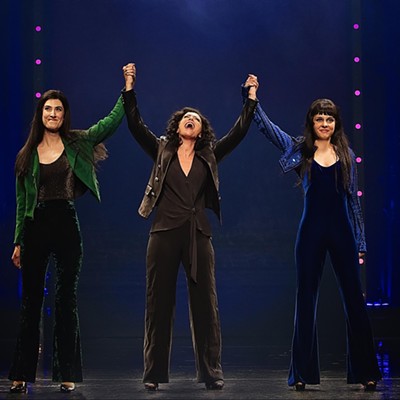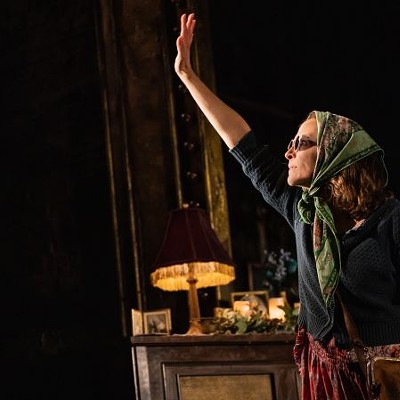
Group Acorde focuses on the intimate and atmospheric with live work for both dancers and musicians.
Photo courtesy of Group Acorde and Nicole Longnecker Gallery
“When we formed last May, we wanted to do something different in the community here,” says Cortes. Group Acorde has already presented at some high-profile dance showcases, including this year’s Barnstorm Dance Fest and Houston Choreographers X6 as part of the Evelyn Rubenstein Jewish Community Center’s Dance Month. The collective presents dance to live music, with musicians occupying the same performing space. This is not a new idea, even in Houston, but the process is. “The idea is about collaboration. When people create original music to original dance, usually the musicians go in their corner and the dancers go in their corner, and then they go back and forth from there. We wanted to see what would happen if we collaborated from the initial idea all the way to presentation, and then what would that look like?”
With about a year and a half of work under their belts, they’ve made some pretty daring choices as far as how audiences digest their work. Earlier this summer, the group presented a two-night performance at the Nicole Longnecker Gallery. “We had this idea of getting out of the theater and going to other venues,” says Cortes. “A lot of people go to galleries, visual-arts people who wouldn’t typically go to see dance. We wanted to bring dance up close to them, so we created something for the space.”"A lot of people go to galleries, visual-arts people who wouldn’t typically go to see dance. We wanted to bring dance up close to them, so we created something for the space." — Group Acorde's Roberta Paixao Cortes
tweet this
Part improvisation, part set choreography, the 40-minute piece moved through both the gallery and the audience. The performers responded not only to each other, but to the work by Japanese artist Harumi Shimazu. “It really became about the art in the space and the audience in that moment,” says Cortes. “Sometimes the relatability of dance is lost if people see us from far away.”
Like the Nobles, Group Acorde was adversely affected by Hurricane Harvey. It had to cancel the August 25 performance of its first full evening concert, Unemojinal, at the Rec Room. Cortes has no qualms about relating to her audience. “The show was about how technology has changed the way we communicate. So many times as a dancer, people will come up to me after a performance and say, ‘I don’t get it.’ Now that I’m a director of a company, I want to really get an idea of what I can do so that something isn’t lacking.” Not only did Unemojinal offer a theme that was palatable, but Groupe Acord also created a photo booth in the lobby. It’s a small detail that goes a long way in making dance ticket holders feel more welcome and a part of the experience.
Cortes and the rest of Group Acorde know that presenting dance in this city will be an uphill battle. Many in the community told them not to move to the nonprofit model, but they’ve done so anyway, hoping that their brand of intimate, thoughtful performances will take them far. According to Cortes, they’re always ready to present at a festival, but the trick will be making this endeavor sustainable for the artists involved.

Laura Harrell’s next project is a synthesis of Houston history and geocaching technology.
Photo by Lynn Lane
“I got the idea a couple of years ago when I was just out of grad school and living on a tight budget,” says Harrell. “My friend Seth and I went geocaching, just to find something to do. Geocaching is an online treasure hunt. You download an app onto your phone, and through the app you see little dots close to where you are.” The dots are caches, and once you navigate to the cache, you’re given a clue and a riddle of where to find it. If you manage to pinpoint it, you sign a log that contains the names of everyone else who has found the cache, and you’re rewarded with a trinket or two. “It’s really about enjoying the chase and the hunt of it all,” she says.
For her project, she’s teaming up with lighting designer David Deveau to film mini-dance-for-cameras at scouted Houston landmarks. She’ll then submit the films as caches, so that Geocache Hunter will receive a write-up of the project and the YouTube link to the dance-for-camera filmed in each location. The clips will add up to an evening-length dance film, which will be presented at 14 Pews sometime in May 2018.
At first glance, the originality of her proposal is apparent, but so is the possibility for generating new dance audiences. “I think the fact that this connects a new population to dance was something that [Houston Arts Alliance] saw potential in,” says Harrell. “It’s also about recognizing Houston and the beauty of it, the architecture and the landmarks and all of the things we have in our backyard that we don’t make time to see.”
Like Cortes, Harrell plans on building her base the old-fashioned way: through interpersonal relationships. “I don’t know if social media works anymore,” she ponders. “I feel like it’s overused, and it’s easy to lose sight of the individual process. It’s hard to keep them straight. I’ve found more success in collaborating and gaining people’s respect and finding people in a more human way.”
————

Ashley Horn’s work combines enjoyable movement, accessible themes and handmade production elements.
Photo courtesy of Ashley Horn
She’ll be presenting at the next Houston Choreographers X6 showcase, in January 2018, and she’s working with the University of Houston’s ensemble through April of next year. She produces Suchu’s annual Comedy Dance Festival, and on that note, she would like to create an evening-length comedic work. But all that pales next to the immediacy of getting through a show run. What she does know is that a rest is in order.
“I need a period of time to regenerate my creative energy,” she says. “I would like to spend some time learning new skills and building new ideas.”
If there is one thing that’s certain, for Wood and everyone else who wants to produce work in Houston, finding people to dance for may be the hardest part of the job.






